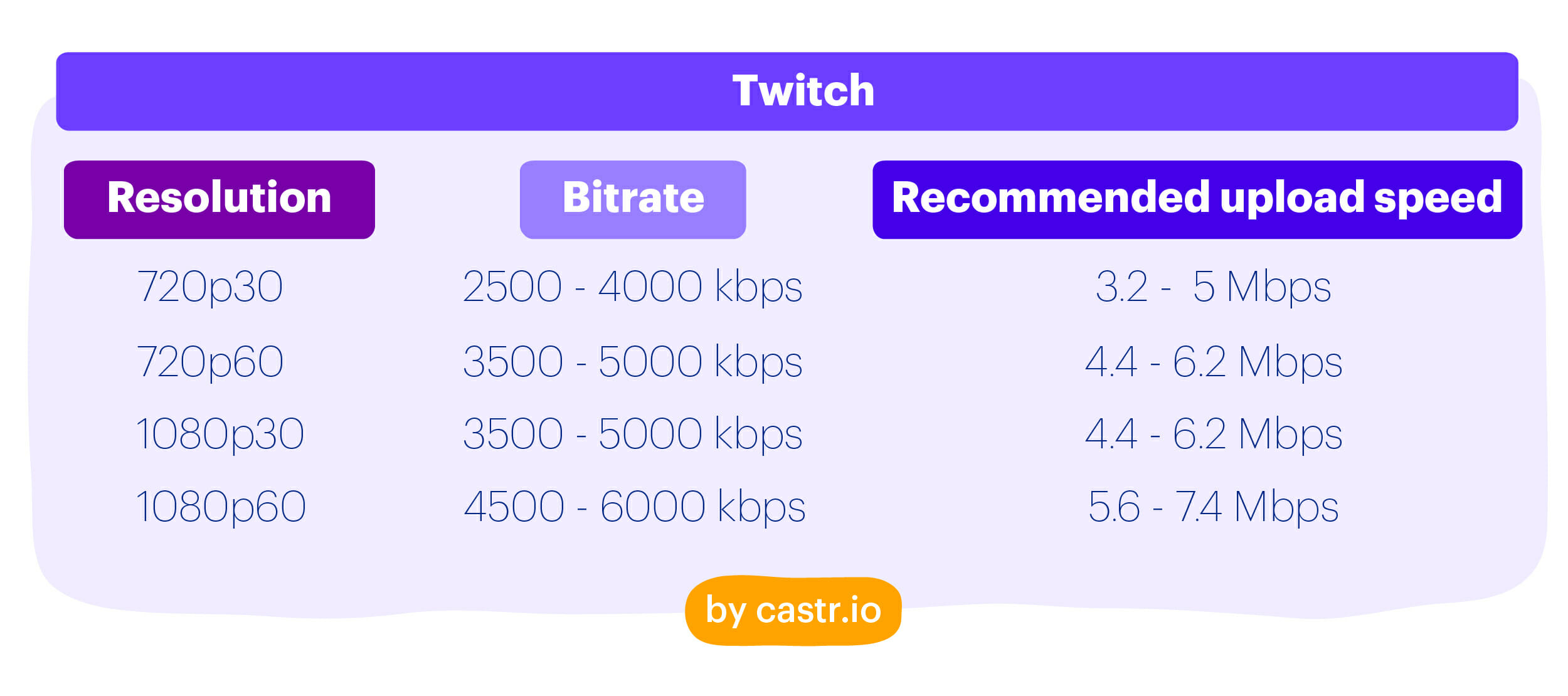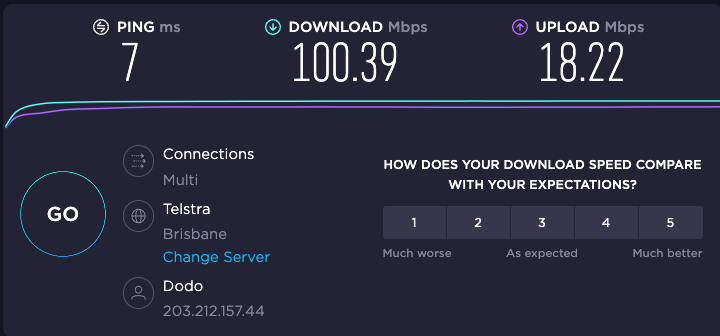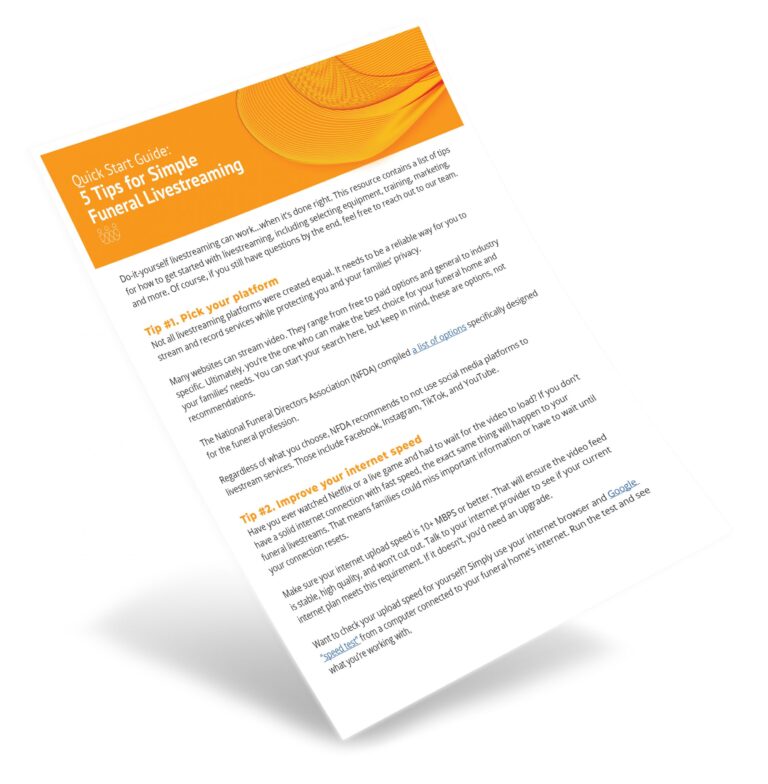Best Upload Speed for Streaming: Optimize Your Experience
When streaming content, a good upload speed is crucial. It ensures smooth, high-quality video without interruptions.
Streaming has become a daily activity for many. Whether you’re sharing gameplay, hosting a live event, or video chatting, a strong upload speed is key. Without it, you risk buffering and poor video quality, which frustrates viewers. The right upload speed can make a big difference in streaming.
It ensures your content is clear and engaging. Understanding the best upload speed for streaming helps you provide the best experience for your audience. In this blog, we will explore the ideal upload speeds needed for various streaming activities. This will help you stream smoothly and effectively.

Credit: castr.com
Importance Of Upload Speed
When streaming live content, upload speed is crucial. It determines how smoothly and clearly viewers receive your stream. High-quality streaming requires robust upload speeds. This ensures a seamless experience for your audience.
Impact On Streaming Quality
Upload speed directly affects streaming quality. Higher speeds result in better resolution and fewer interruptions. Poor upload speed can lead to pixelated images. It can also cause audio issues.
For HD streaming, aim for at least 3 Mbps upload speed. For 4K streaming, 15 Mbps or higher is recommended. Consistent upload speeds maintain the quality throughout the stream.
Avoiding Buffering
Buffering is a viewer’s nightmare. It ruins the experience. Low upload speed often causes buffering. The stream cannot send data fast enough. This results in pauses and stutters.
A stable upload speed prevents buffering. It keeps the stream flowing smoothly. Invest in a good internet plan. This helps avoid buffering issues.
Factors Affecting Upload Speed
Understanding the factors that affect upload speed is crucial for a smooth streaming experience. Many elements can influence how quickly data moves from your device to the internet. Knowing these factors can help you optimize your upload speed and avoid interruptions during your streams.
Internet Connection Type
The type of internet connection you use greatly impacts your upload speed. Fiber-optic connections generally offer the highest upload speeds. They use light to transmit data, which is much faster than traditional methods. Cable connections are also reliable but usually provide slower upload speeds than fiber. DSL connections tend to have even lower upload speeds. These connections use old phone lines, which are not as efficient. Satellite connections often have the slowest upload speeds. They rely on data traveling to and from satellites in space, causing delays.
Network Congestion
Network congestion occurs when many users are online at the same time. This can slow down your upload speed. During peak hours, such as evenings or weekends, more people use the internet. This increased usage can lead to slower speeds for everyone. To avoid this, try streaming during off-peak hours. Another way to reduce network congestion is to limit the number of devices connected to your network. Each device uses a portion of your available bandwidth. Disconnecting devices you are not using can help improve your upload speed.
Recommended Upload Speeds
When it comes to streaming, ensuring you have the right upload speed is crucial for a smooth experience. Whether you are streaming in standard or high definition, the upload speed plays a significant role in the quality of your stream. Let’s break down the recommended upload speeds for different streaming resolutions to help you provide the best viewing experience for your audience.
Standard Definition Streaming
For standard definition (SD) streaming, you don’t need a massive upload speed. Usually, an upload speed of 1.5 Mbps is sufficient. This will allow you to stream without interruptions or lag.
I once tried streaming a live cooking session in SD with just 1 Mbps. It worked, but there were occasional buffering issues. Increasing it to 1.5 Mbps made a noticeable difference.
If your audience is on a slower internet connection, SD streaming can be a good choice. It requires less bandwidth while still delivering decent quality. Have you checked your current upload speed? It might be time to upgrade.
High Definition Streaming
High definition (HD) streaming is more demanding. You will need an upload speed of at least 3 to 5 Mbps. This ensures your stream is clear and free from annoying interruptions.
Once, during a gaming session, I upgraded my upload speed to 4 Mbps to stream in HD. The difference was night and day. The stream was smooth, and the video quality was sharp.
Planning to stream in 1080p? Aim for the higher end of the spectrum, around 5 Mbps. This will keep your stream looking professional and engaging. Is your current setup ready for HD streaming? It could be the key to growing your audience.
Testing Your Upload Speed
When you’re streaming, your upload speed can make or break your experience. Testing your upload speed is essential to ensure a smooth, buffer-free stream. This simple step helps you identify if your current internet setup meets the demands of your streaming needs.
Using Online Tools
Online tools are a quick and easy way to test your upload speed. Websites like Speedtest.net or Fast.com offer free services. Just visit the site, click on the ‘Go’ button, and wait for the results.
These tools measure your upload speed in megabits per second (Mbps). They also show your download speed and ping. The higher the upload speed, the better your stream quality will be.
Interpreting The Results
Once you have your results, it’s time to interpret them. A good upload speed for streaming is at least 3 Mbps. This ensures that your stream is smooth and free from interruptions.
If your upload speed is below 3 Mbps, you might face buffering or poor video quality. Consider upgrading your internet plan or switching to a different provider.
Testing your upload speed regularly keeps your streaming experience top-notch. Have you ever faced buffering issues while streaming? Testing your speed could reveal the culprit. Take action and enjoy smooth streaming every time!
Improving Your Upload Speed
Improving your upload speed can make a world of difference in your streaming experience. Whether you’re a gamer, a content creator, or someone who enjoys live video calls, a faster upload speed ensures smoother and more reliable connections. Let’s dive into practical ways to boost your upload speed.
Upgrading Your Plan
If your upload speed is consistently slow, it might be time to check your internet plan. Not all plans are created equal when it comes to upload speeds. Most providers offer different tiers of service; some are better suited for streaming than others.
For instance, if you’re on a basic plan, consider upgrading to one that offers higher upload speeds. Contact your ISP to discuss available options. They might have a plan specifically designed for heavy upload users like streamers.
Upgrading your plan might cost more, but the investment can pay off with fewer lags and smoother streams. How much is a flawless streaming experience worth to you?
Optimizing Your Network
Sometimes, the issue isn’t your internet plan but your home network setup. Start by ensuring your router is up to date. Firmware updates can improve performance significantly.
Place your router in a central location to minimize distance to your devices. Avoid physical obstructions and interference from other electronics. If you have multiple devices connected, ensure they are not hogging bandwidth. Consider using Quality of Service (QoS) settings to prioritize streaming traffic.
Wired connections can be more reliable than Wi-Fi. If possible, connect your streaming device directly to your router using an Ethernet cable. This simple step can dramatically improve your upload speed.
Have you tried these methods? Which one made the biggest difference for you? Share your experiences in the comments!

Credit: restream.io
Equipment Considerations
Choosing the right equipment is crucial for optimal streaming. Quality devices ensure smooth and uninterrupted streams. Let’s explore two key aspects: router and modem quality, and wired vs. wireless connections.
Router And Modem Quality
Your router and modem play a big role in streaming. A high-quality router can handle more data. This means less buffering. Ensure your modem is up-to-date. Older modems might not support faster speeds. Check your Internet Service Provider’s recommendations. Often, they have a list of compatible devices.
Wired Vs. Wireless Connections
Wired connections are generally more stable. They provide consistent speeds. Use an Ethernet cable for the best results. Wireless connections can be convenient. But, they might be less reliable. Wi-Fi signals can be interrupted by walls and other devices. If using Wi-Fi, place the router in a central location. This helps in getting a stronger signal.
Dealing With Isp Limitations
Streaming requires a good upload speed for clear video. Aim for at least 5 Mbps to avoid buffering. This ensures smooth, high-quality viewing experiences.
Streaming requires a reliable and fast upload speed. But, Internet Service Providers (ISPs) sometimes limit speeds. This can affect your streaming quality. Understanding these limitations helps you manage and optimize your connection.Understanding Data Caps
Many ISPs impose data caps. A data cap limits the amount of data you can use each month. Streaming uses a lot of data. HD and 4K streams consume even more. Exceeding your data cap can lead to throttled speeds or extra charges. Knowing your data limit helps you avoid unexpected costs.Negotiating With Providers
You can negotiate with your ISP for better terms. Ask for higher data caps or faster upload speeds. Sometimes, ISPs have special plans for heavy users. Explain your streaming needs clearly. They may offer a plan that fits you better. Always review your bill for any changes. “`
Credit: golightstream.com
Advanced Tips For Streamers
For streamers, ensuring the best upload speed is crucial. Advanced tips can make a significant difference. By tweaking certain settings, you can achieve a smoother streaming experience. Let’s delve into some advanced tips that can help you optimize your streaming setup.
Using Qos Settings
Quality of Service (QoS) settings can greatly improve your streaming. These settings prioritize your streaming traffic over other types of traffic. This means your stream gets the bandwidth it needs, even if others are using the network.
To use QoS settings, access your router’s admin panel. Look for the QoS section. Here, you can set your streaming device to high priority. This ensures your stream remains stable. Experiment with different settings to find the best configuration for your needs.
Prioritizing Streaming Traffic
Prioritizing streaming traffic ensures your stream gets the required bandwidth. This can be done through your router settings. Locate the traffic management section in your router’s admin panel.
Select your streaming device and set it as the highest priority. This way, your router allocates more bandwidth to your stream. This results in fewer interruptions and a smoother experience.
Some routers offer advanced options for traffic prioritization. Explore these options to enhance your streaming further. Consistently monitor your stream quality. Adjust settings as necessary to maintain optimal performance.
Frequently Asked Questions
Is 10 Mbps Upload Speed Good For Streaming?
Yes, 10 Mbps upload speed is good for streaming. It supports HD quality and smooth performance without buffering.
What Upload Speed Is Good For Streaming?
A good upload speed for streaming is at least 3 Mbps for standard quality and 5-10 Mbps for HD quality. For 4K streaming, aim for 20-30 Mbps.
Is 20 Mbps Upload Speed Good For Live Streaming?
Yes, 20 Mbps upload speed is good for live streaming. It ensures smooth, high-quality video without interruptions.
Is 50 Mbps Upload Speed Good For Streaming?
Yes, 50 Mbps upload speed is good for streaming. It ensures smooth, high-quality streams without buffering issues.
Conclusion
Choosing the right upload speed is crucial for smooth streaming. It ensures clear, uninterrupted content for your audience. Aiming for at least 10 Mbps can make a big difference. Always test your connection regularly. Upgrading your plan might be necessary if you face issues.
Remember, better upload speeds lead to better streaming experiences. Stay connected, and enjoy your streaming journey!






